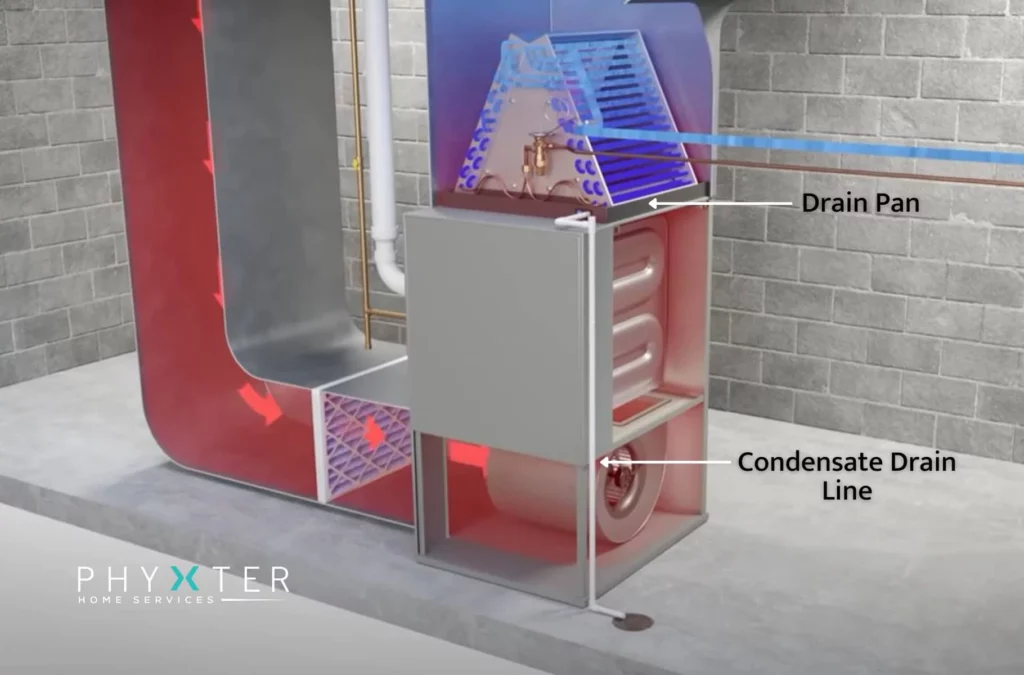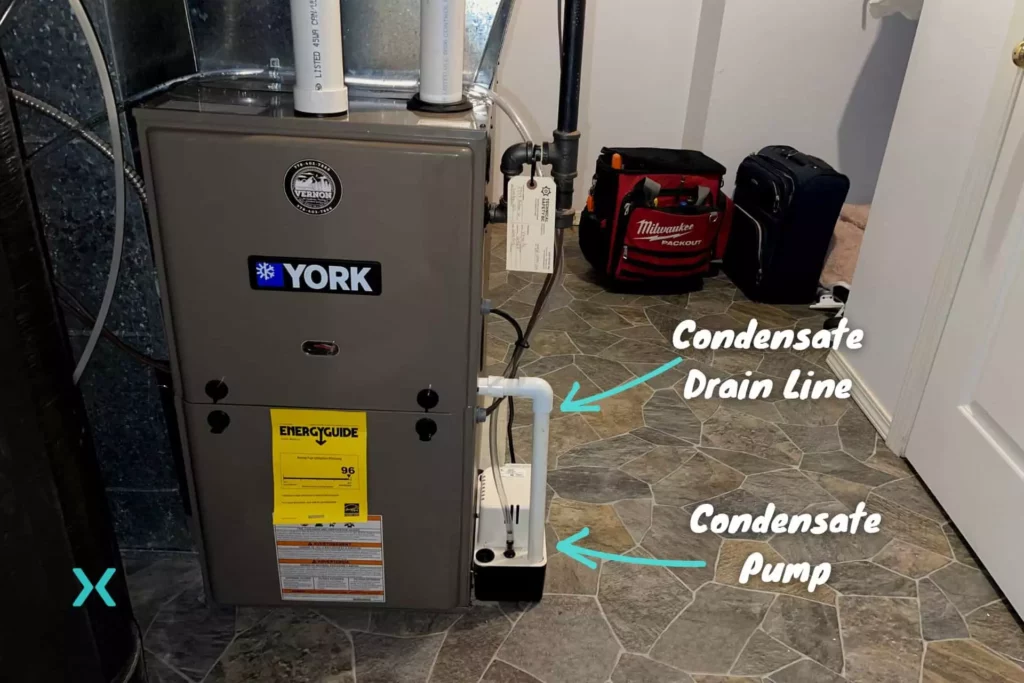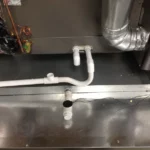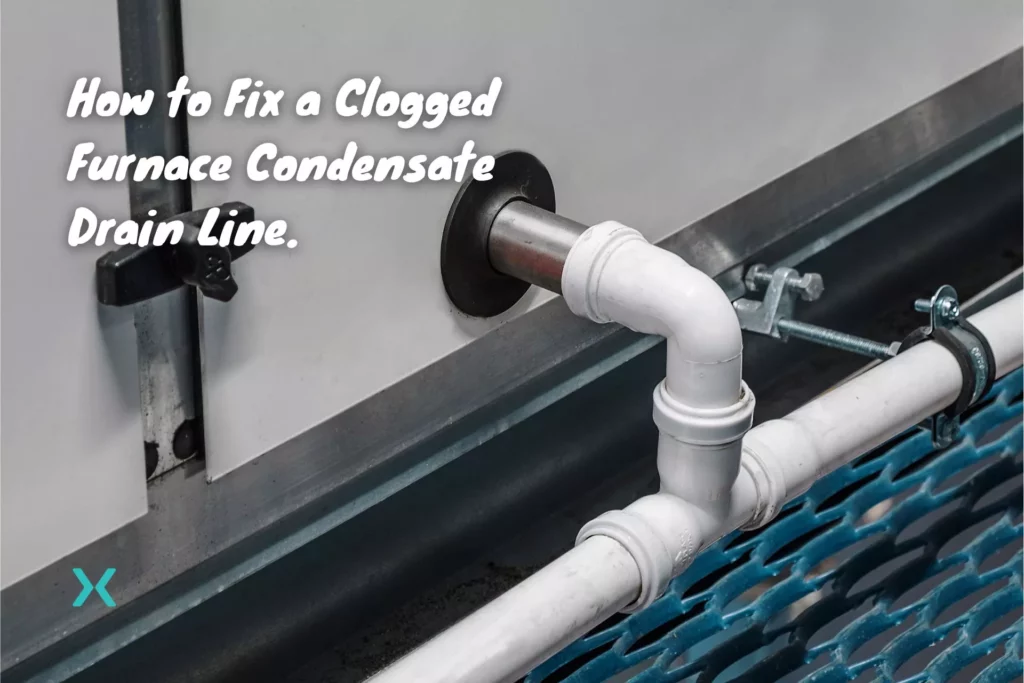🔥 How to Fix a Clogged Furnace Condensate Drain Line.
If you have a high-efficiency gas furnace and it won’t run, one of the reasons could be a clogged drain line. If you’re not sure, the simple way to check is to look for a little clear ‘Sight Glass‘ and to count how many times the red light flashes.
There will be a flash code list on either the front or back of the furnace access door. If the code for the number of flashes you counted is something related to a pressure switch or the condensate drain line, then you might have a clogged condensate drain.
Table of Contents
🔥 How to Unclog Your Furnace’s Condensate Drain

There are multiple ways to unclog the drain line, but how easy it is will depend on how well the furnace was installed.
If it was installed with maintenance in mind, then a removable p-trap or drain trap should be installed; if there is, then simply remove it, and rinse it out in your sink.
Make sure to re-fill it with clean water prior to putting it back in.
If it’s not removable, or there isn’t a drain trap installed, then your job just got a little more difficult.
Some tools you might be able to use to unclog your furnace condensate drain.
🔥 How to use Different Tools to Unclog Your Condensate Line:

- Drain snake – using a flexible wire brush by pushing it up or down the condensate trap can not only clear the blockage but also clean the inside of the condensate line, reducing the chances of future blockages. You can purchase flexible drain brushes that are over five feet long. If that’s not long enough, you’ll need to look for another solution to your clogged condensate drain tube.
- CO2 gun – this is a tool that HVAC technicians use to blow out the drain line quickly. It’s a quick fix and won’t stop future blockages. After blowing out the drain line, you would want to clean it with white vinegar or hot water and soap.
- Wet and Dry Vacuum – using a wet and dry vacuum to unclog a furnace condensate drain line requires a little ingenuity, as you’ll need to seal the suction end of the vacuum around the condensate line so that it’s air-tight. The wet and dry vacuum will clear blockages halfway up the drain line if done properly.
- PVC cutter or hack saw – these tools will be used to remove the condensate line so you can work on it more easily.
- PVC glue, PVC pipe, and a PVC coupling (usually 3/4″) – these materials will be needed to put condensate drains back together.
Before we get started, let’s learn about why condensate drain lines get plugged in the first place.
🔥 Why Does a Condensate Line Get Clogged In The First Place?
When a high-efficiency gas furnace burns fuel, it creates acidic condensation that can cause slime and rust to build up in the condensate p-trap.
There’s nothing you can do about this other than to ensure the furnace is operating as designed by having it looked at annually by an experienced HVAC technician.
🔥 What is a Condensate Pump Float Switch For?
A condensate pump float switch is for stopping the furnace from running when there is an issue with the condensate pump that stops it from safely pumping the condensation to a drain line.
If your furnace isn’t running and your condensate pump is full, you might need a new one.
🔥 What is a Condensate Drain Pan For?

A condensate drain pan is used as a backup for when the primary drain pan or condensate line gets blocked or plugged.
If this happens, the primary drain pan could overflow and leak into the secondary condensate drain pan.
This drain pan will have its dedicated drain line.
🔥 Why Does a High-Efficiency Furnace Make Condensate?
A high efficient furnace makes condensate because it burns such a high percentage of fuel that most of the exhaust is water vapor.
The exhaust cools down because of the effectiveness of the heat exchanger, and when that exhaust comes in contact with the cooler PVC exhaust tubes, it condenses into water droplets.
The furnace venting is designed to slope back to the furnace so that the water droplets can make their way back to the drain line and eventually to the home’s plumbing drains.
If a high-efficient furnace isn’t set up properly upon installation, the combustion process can be affected to a point where flue gases traveling through the exhaust system can create excess moisture.
This is usually caused by improper gas pressures.
Another negative side effect of improper gas pressures or excess moisture is premature rusting and heat exchanger failure.
🔥 Where Can I Drain My Condensate Line?
Most homes can drain their condensate line to the floor drain, but if you’re on a septic system, then the answer is a little more complicated.
When a furnace burns a gas, the condensation is technically clean. However, the PH is usually between 2.9 and 4, which makes it acidic.
This can cause damage to pipes, septic systems, water treatment facilities, and more.
In order to safely drain furnace condensate, you should have a condensate neutralizer installed.
The condensate water travels through the neutralizer, which includes calcium carbonate, CO2, and salt, which neutralizes the acid and makes the condensate safe for your septic system.
🔥 Other Symptoms of Furnace or AC Condensate Drain Issues
🔧 Water Damage
If you have a clogged condensate line or a condensate pan overflows, you may notice water on the floor around your HVAC system, water stains on nearby walls, or if the HVAC system is installed in the attic, then you might have water stains on the ceiling.
🔧 Musty Smells or Odors in Your Home
Condensate drainage issues with your HVAC system lead to excess moisture in your home.
As this excess moisture stagnates in your HVAC system, the odors travel through your ductwork and circulate throughout your home.
If you’re noticing musty or moldy odors in your home, the first place to check is your HVAC system.
🔧 Excess Condensation Indoors or on Windows
If it’s not raining outside, you haven’t turned up your humidifier, and you still have condensation around the edges of your windows, you might have a problem with your furnace or air conditioner condensate drain line.
Check the drain line coming out of the AC evaporator coil and the drain line coming out of the furnace.
🔧 Higher Energy Bills
This mostly relates to the summer as an air conditioner dehumidifies, so if your drain line isn’t working properly, your AC will have to work harder to cool the house.
If your utility bills are higher than normal, you should check to ensure there are no signs of a condensate drainage issue.
🔧 Poor Indoor Air Quality
Does it feel muggy or cold and clammy in your home?
Are you finding your allergies to be worse than usual?
Then high humidity levels caused by drain line issues could be the cause.
Check your system for the signs mentioned in this article, or call an experienced HVAC technician for help.
🔧 Mold Growth Inside Your Home
Mold thrives in warm and humid climates and can initially be seen around the furnace.
If left unchecked, mold will spread throughout the home and can cause significant health issues for you and your family.
To ensure that problematic HVAC drains aren’t your issue, you should have an HVAC contractor perform annual maintenance on your HVAC equipment.
🔥Final Thoughts on Clogged Condensate Drain Lines

Hopefully, this article has helped you to determine whether you have a clogged drain line or how to unplug it.
If you can’t fix your issue or are not comfortable doing this yourself, then we recommend contacting a highly-rated HVAC contractor in your area.
If you found this helpful but didn’t solve your problem, you can check out some of our other furnace repair articles.

